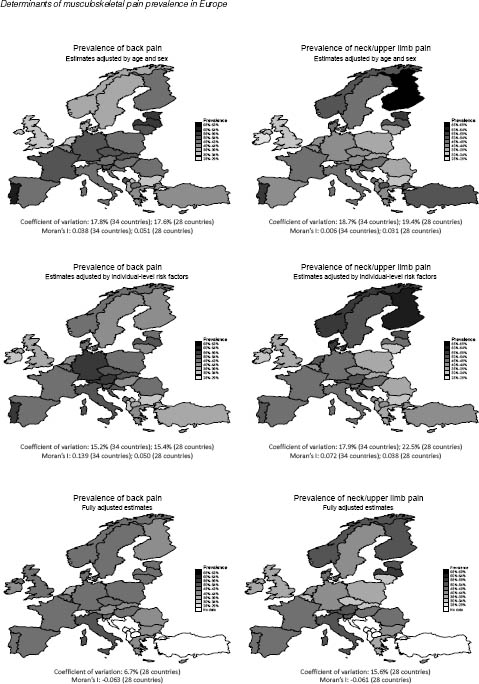In western countries, painful disorders of the back, neck and upper limb are major causes of work disability (1). Most early studies on causes of musculoskeletal pain focused on physical exposures, such as manual material handling, repetitive movements, awkward postures, and vibration (2). More recently, important psychological risk factors – in particular low mood and somatizing tendency – have also been demonstrated (3–6). In addition, the role of work-related psychosocial factors has been explored (7), often using Karasek’s job demand–control model (8), although with less consistent results.
It seems unlikely, however, that these individual-level risk factors can fully explain the variation in occurrence of musculoskeletal pain and associated disability that has been observed between countries and within countries over the time (9–11). This raises the possibility of a contribution also from socioeconomic factors operating at a population-level, such as provision of healthcare and social security, and attention to occupational health and safety.
To explore the variation in common musculoskeletal symptoms between European countries, and the extent to which it might be explained by individual-level risk factors and national socioeconomic circumstances, we analyzed data from the fifth European Working Conditions Survey (EWCS) and from Eurostat (12, 13).
Methods
Study population and setting
The European Foundation for the Improvement of Living and Working Conditions conducted the fifth EWCS in 2010. Carried out every five years, the survey uses a harmonized approach to investigate the working conditions of employees and the self-employed across Europe. A detailed description of the methods has been published elsewhere (14). Briefly, the survey was carried out in the 27 Member States of the European Union (EU), and also in Norway, Republic of Macedonia, Croatia, Turkey, Albania, Kosovo, and Montenegro. A standardized questionnaire (14) was administered at interview to random samples, stratified by sex and age, of all persons aged ≥15 years (≥16 in Spain, the UK and Norway), who resided in specified regions of the participating countries and were thought to have been in employment during the previous week. Interviews were conducted among 43 816 respondents in their homes, giving an overall response rate of 59.6%.
Health outcomes
Among other items, the questionnaire asked whether the participant had suffered from back or neck/upper-limb pain during the past year. These two outcomes were related to individual-level risk factors derived from the questionnaire and also to various socioeconomic risk factors defined by country.
Individual-level risk factors
The individual-level risk factors studied were: sex; age; educational level; socioeconomic status; time spent on housework or cooking; time spent on gardening and repairs; somatizing tendency; job demand–control; frequency of six physical exposures at work; and occupational group.
Age was classified in five ten-year categories. A three-level variable was created for education (primary or lower; secondary; tertiary) by collapsing the seven levels of the International Standard Classification of Education (15). The full method of the European Socioeconomic Classification (16) was used to assign subjects to three socioeconomic classes (salariat, intermediate, and working class) according to their job title [classified according to the 1988 version of the International Standard Classification of Occupations (ISCO-88)], employment status (employer, self-employed, or employee), and the size of the organization in which they worked. Time spent on housework or cooking and on gardening and repairs was graded to three levels by aggregating categories from a six-level scale that had been used in the questionnaire. This aggregation was based on observed frequencies, and was carried out before associations with health outcomes were examined. Somatizing tendency was graded according to how many symptoms from a total of four (stomach ache, respiratory difficulties, overall fatigue, and headaches/eyestrain) the participant reported in the past year.
Classification of job demand–control was based on Karasek’s model (8). Three scales where created from the EWCS questionnaire: job demand (7 items), job skill discretion (6 items), and job decision-making authority (3 items). Job decision-latitude, representing job control, was calculated as the sum of job skill discretion and job decision-making authority, weighting for the number of items in each scale. Scores for job demand and job decision-latitude were then dichotomized using their median values, and four categories of job demand–control were defined: low-strain jobs (low demand, high decision-latitude); passive jobs (low demand, low decision-latitude); active jobs (high demand, high decision-latitude); and high-strain jobs (high demand, low decision-latitude). A more detailed description of the methods by which job demand–control was specified is presented online in Appendix 1 (www.sjweh.fi/data_repository.php).
The occupational physical exposures analyzed were frequency of: carrying or moving loads; lifting or moving people; standing; exposure to vibrations; repetitive hand or arm movements; and working with computers. The questionnaire asked about the proportion of working time that was occupied by these activities, with seven possible answers collapsed to four categories: never, sometimes (including “almost never” and “around ¼ of the time”), often (including “around ½ of the time” and “around ¾ of the time”), and always (“almost all of the time” or “all of the time”).
National socioeconomic risk factors
Data on potentially relevant socioeconomic variables defined at the national level were obtained from Eurostat (13)and available for all but six countries (Albania, Croatia, Former Yugoslav Republic of Macedonia, Kosovo, Montenegro, and Turkey). When complete information on a variable was available for 2010, this was used; otherwise, data were taken from the most recent year for which they were complete. To enhance comparability, all variables were standardized to have mean 0, standard deviation (SD) 1. The following statistics were examined: (i) people at risk of poverty or social exclusion (2010); (ii) in-work at-risk-of-poverty rate (2010); (iii) gross domestic product per capita in purchasing power standards (2010); (iv) material deprivation rate (2010); (v) distribution of income measured with Gini Index (2010); (vi) hospital beds per 100 000 inhabitants (2007); (vii) school expectancy (expected years of education over a lifetime) (2010); (viii) public expenditure on labor market policies, category 1 (publicly funded services for job-seekers) (2007); (ix) public expenditure on labor market policies, categories 2–7 (training, supported employment and job creation) (2007); (x) public expenditure on labor market policies, categories 8–9 (unemployment and early retirement benefits) (2007); (xi) public expenditure on education (2005); (xii) expenditure on social protection (2008); (xiii) fatal accidents at work: incidence rate (2005); (xiv) fatal accidents at work: trend (2006 compared to 1998); (xv) healthy life expectancy at birth (2010); (xvi) self-reported unmet need for medical examination or treatment (2010); and (xvii) unemployment rate (2010).
A detailed description of these variables is provided online in Appendix 2 (www.sjweh.fi/data_repository.php).
Statistical analysis
Statistical analysis was carried out using Stata 11.2 SE (Stata Corp, College Station, TX, USA). Associations of pain outcomes with risk factors were characterized by prevalence ratios (PR) and associated 95% confidence intervals (95% CI), estimated by fitting Poisson regression models with robust estimates of variance (17, 18). To account for clustering within the study sample, we allowed for random effects (ie, intercepts) by country. Supplementary analyses were carried out with random intercepts for region as well as country to ensure there was no important additional clustering by region. Subjects with missing information on one or more of the variables in an analysis were excluded from that analysis.
Multilevel methods were used to study country-level risk factors in the same models as individual-level risk factors (19). In view of the large sample size, all of the individual-level risk factors were included in the final multivariate models. However, the number of socioeconomic risk factors defined at national level was large compared with the number of countries. Therefore, to develop a suitably parsimonious model, we applied forward selection based on the Wald test, adding variables that produced a significant (P<0.05) improvement in fit. To avoid problems associated with colinearity, national attributes that were strongly interrelated (Pearson’s r>0.70) were never included together in the same model. A matrix setting out Pearson’s correlation coefficients for pairs of country-level risk factors is presented in Appendix 2. Subjects from countries with missing data on socioeconomic variables at national level were excluded from the analysis of country-level risk factors.
Adjusted prevalence rates by country were estimated by summing the fixed and the random effects from logistic regression models with random effects (ie, intercepts) by country such that:
Prevalence = 1/(1+exp(-1*(linear prediction for the fixed effect + linear prediction for the random effect))). Prevalence rates by occupation were estimated as average marginal effects from the fixed effects portion of the models. Coefficients of variation in prevalence rates were calculated as the ratio of SD to mean.
The overall spatial autocorrelation of prevalence rates between neighboring countries was studied with Moran’s I (20), ranging from -1 (perfect dispersion) to 1 (perfect correlation), with a value of 0 meaning no spatial autocorrelation.
Results
From the original sample of 43 816 subjects, we excluded 1926 who did not confirm having been at work (as an employee or employer/self-employed) during the past week (984 aged ≥65 years, and 191 with unknown age). We also excluded 5931 participants with missing data on individual-level risk factors (principally job demand–control, N=4346). Thus, 35 550 subjects (81.1% of the original sample) entered our main analysis. A flow diagram for the study is presented in figure 1.
Figure 1
Flow diagram for study. Fifth European Working Conditions Survey, 34 European countries, 2010.
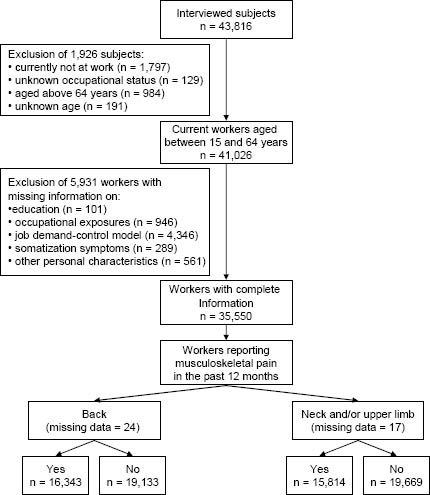
The overall one-year prevalence of back pain in the study sample was 46.1% (95% CI 45.5–46.6) and 44.6% (95% CI 44.1–45.1) for neck/upper-limb pain. Figure 2 gives age- and sex-adjusted prevalence rates for back and neck/upper-limb pain by occupation and country. The prevalence of both outcomes varied substantially between occupations, with relatively low values among teaching professionals (32.2% for back and 31.7% for neck/upper-limb pain) and the highest rates in agricultural, fishery, and related laborers (64.0% and 67.3%, respectively). Moreover, there was a high correlation (Pearson’s r=0.97) between rates of back and neck/upper-limb pain by occupation, and this applied to both manual and non-manual workers. Major differences in prevalence were also observed by country with back pain more than twice as common in Portugal (63.8%) than Ireland (25.7%), and rates of neck/upper-limb pain ranging from 26.6% in Ireland to 67.7% in Finland. The correlation between back and neck/upper-limb pain by country (Pearson’s r=0.54) was less strong than by occupation.
Figure 2
Prevalence of back and neck/upper-limb pain by occupation (2-digit ISCO-88) and country. Fifth European Working Conditions Survey, 34 European countries, 2010.
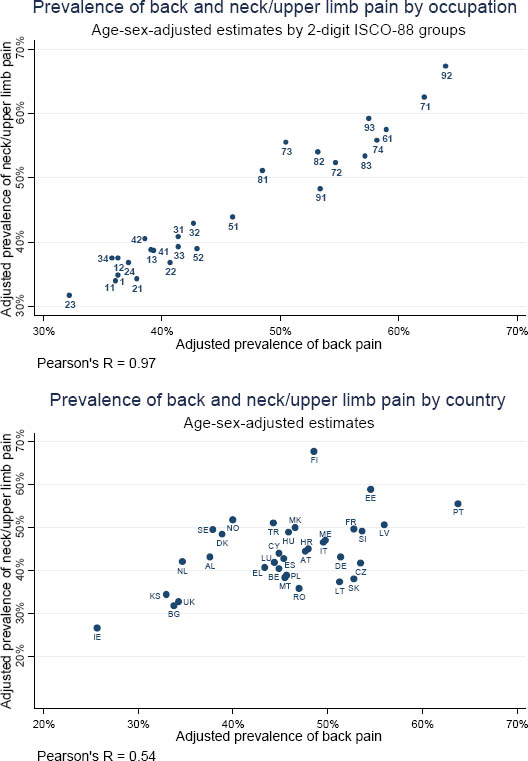
Table 1 summarizes the associations (mutually adjusted and adjusted also for occupation) of pain in the back and neck/upper limb with individual-level risk factors. For both anatomical sites, the prevalence of pain increased with age, and was somewhat higher among women than men, and with lower educational level. However, after adjustment for educational level and occupation, no association was apparent with socioeconomic class. Housework or cooking for more than one hour per day was associated with both back and neck/upper-limb pain (PR for both=1.11), but no clear associations were observed with frequency of gardening and repairs. The strongest associations were with number of somatic symptoms over the past year [PR for subjects reporting ≥2 versus 0 symptoms was 2.43 (95% CI 2.33–2.53) for back pain and 2.59 (95% CI 2.48–2.71) for neck/upper-limb pain]. The classification of subjects according to the job demand–control model suggested that active and high-strain jobs (both characterized by high job demand) were a risk factor for both back and neck/upper-limb pain. The physical occupational exposures analyzed showed mostly positive associations with the two pain outcomes, the two strongest associations being between, on the one hand, carrying or moving heavy loads and back pain and, on the other hand, repetitive hand or arm movements and neck/upper-limb pain. However, frequent work with computers tended to carry a lower risk of pain. Analyses stratified by sex are presented online in Appendix 3 (www.sjweh.fi/data_repository.php).
Table 1
Associations between musculoskeletal pain in past year and personal characteristics. Fifth European Working Conditions Survey, 34 European countries, 2010. [95% CI=95% confidence interval; ESEC=European socioeconomic classification; PR=prevalence ratio; Ref=reference category]
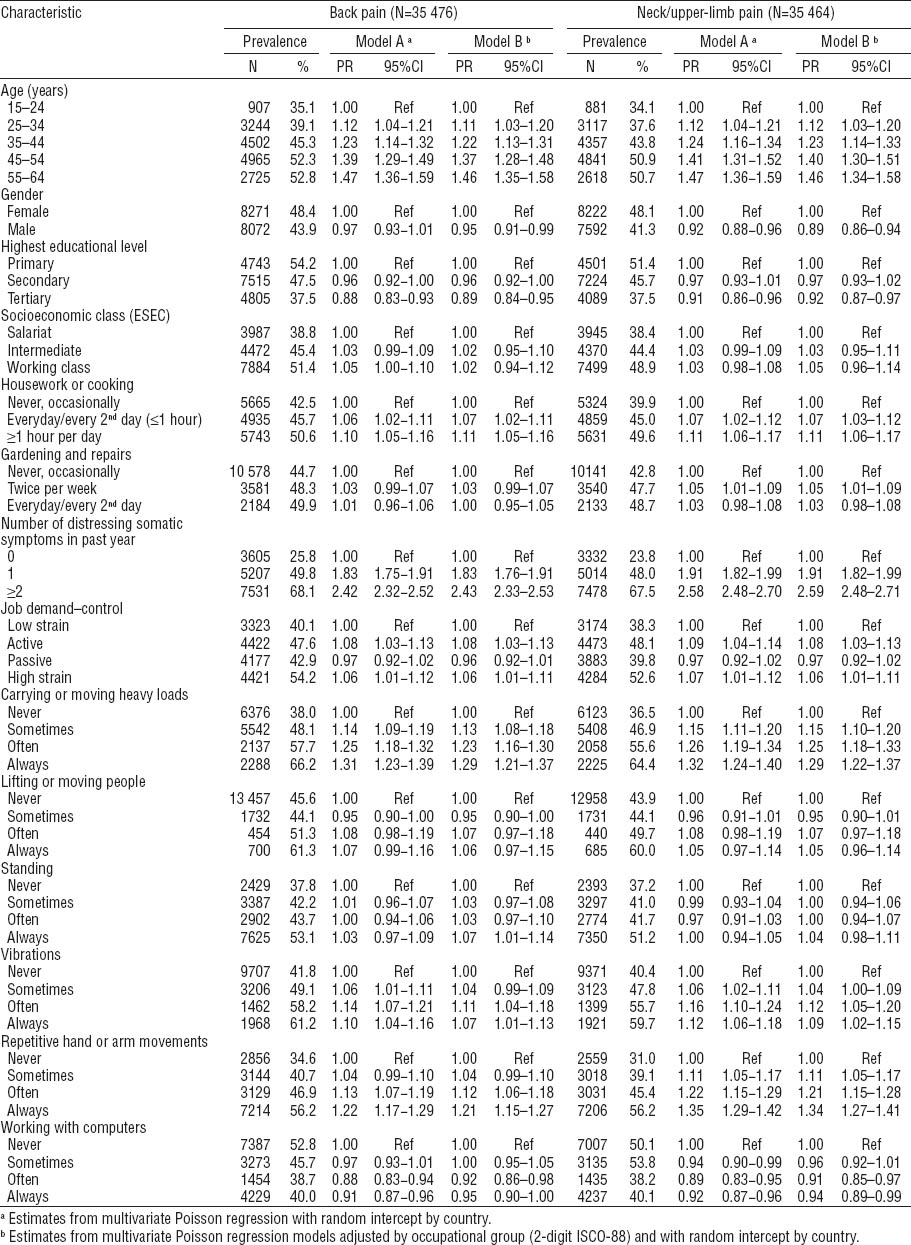
Table 2 shows risk estimates for back and neck/upper-limb pain by occupational group. For both outcomes, adjustment for other personal characteristics in addition to sex and age considerably reduced the strength of the observed associations. This effect was driven largely by the psychosocial and physical occupational risk factors. Compared to teaching professionals, the highest fully adjusted PR for back pain were observed among manual workers such as drivers and mobile-plant operators (PR=1.36), market-oriented skilled agricultural and fishery workers (PR=1.28), extraction and building trades workers (PR=1.29), and agricultural, fishery and related laborers (PR=1.28). Adjusted PR for neck/upper-limb pain were generally lower than for back pain. Again, higher risks were observed among manual workers such as agricultural, fishery and related laborers (PR=1.29), extraction and building trades workers (PR=1.25), precision, handicraft, printing and related trades workers (PR=1.24), and drivers and mobile-plant operators (PR=1.22).
Table 2
Associations between musculoskeletal pain in past year and occupational groups. Fifth European Working Conditions Survey, 34 European countries, 2010. [95% CI=95% confidence interval; PR=prevalence ratio; Ref=reference category]
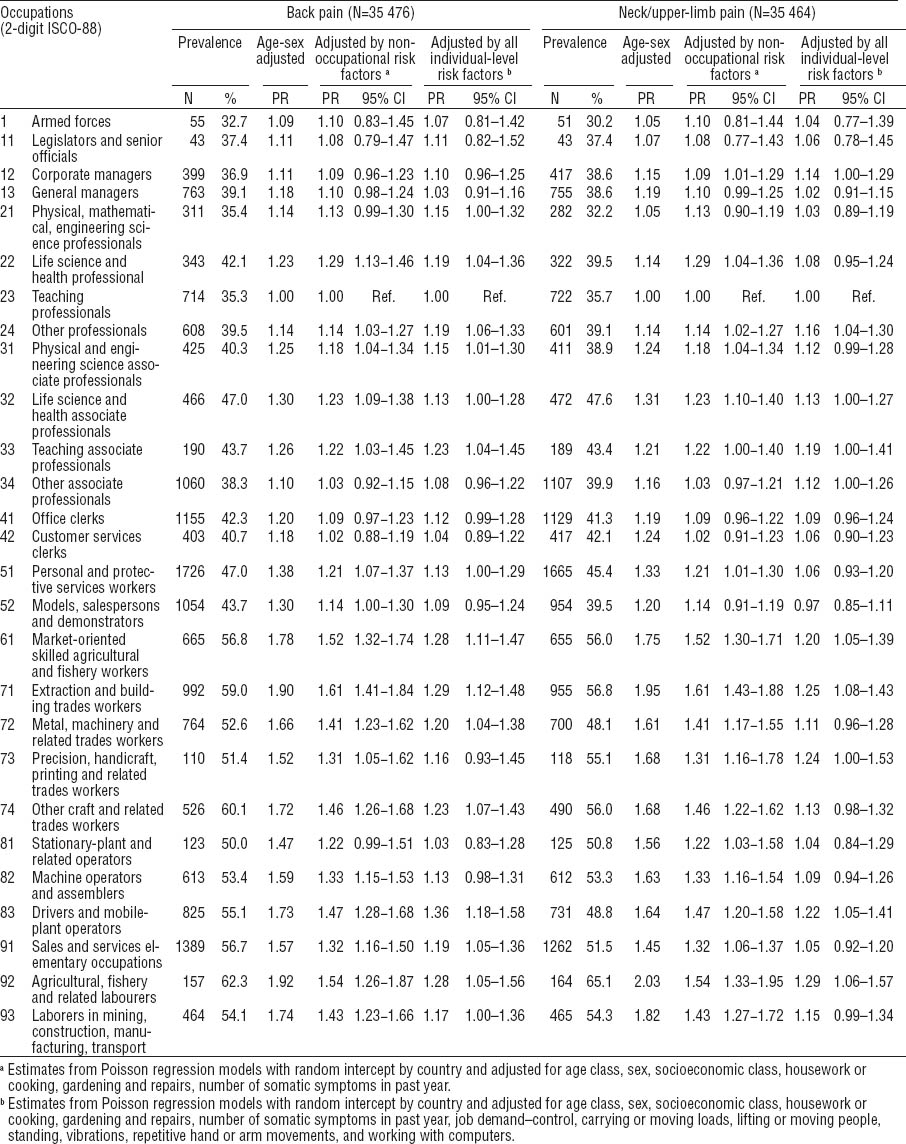
Table 3 shows the relation of national socioeconomic risk factors to back and neck/upper-limb pain, after adjustment for individual-level risk factors including occupation. For both anatomical sites, the prevalence of pain was lower in countries with a higher percentage of people at risk of poverty or social exclusion. Positive associations with back pain were also observed for higher expenditure on social protection, higher rate of fatal accidents at work, and more self-reported unmet need for medical examination or treatment. Conversely, higher public expenditure on education and longer healthy life expectancy at birth were associated with a lower risk of back pain. When risk estimates were mutually adjusted, only school expectancy was positively associated with neck/upper-limb pain.
Table 3
Associations between musculoskeletal pain in past year and national socioeconomic risk factors. Fifth European Working Conditions Survey, 28 European countries, 2010. [95% CI=95% confidence interval; PR=prevalence ratio]
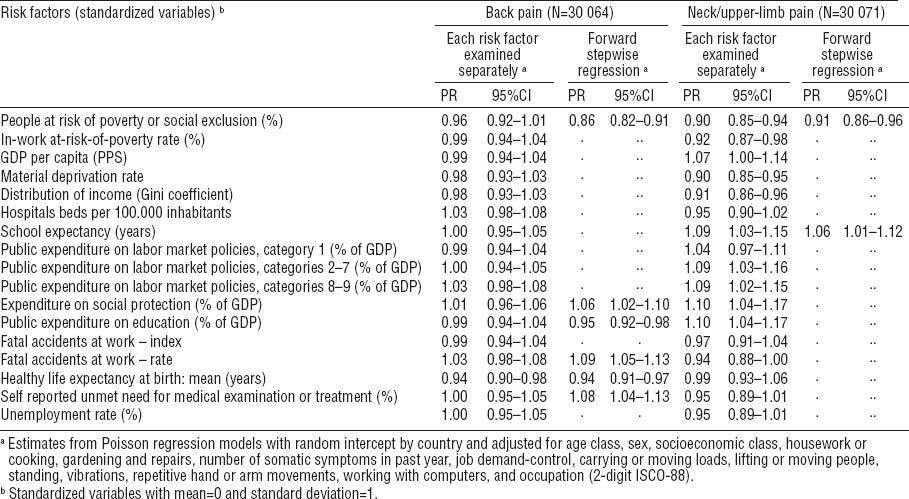
Figure 3 summarizes the distribution of one-year prevalence rates for back and neck/upper-limb pain across Europe. Prevalence maps were plotted for rates adjusted for age and sex, for all individual-level risk factors (parameterized as presented in tables 1 and 2), and for all individual-level risk factors together with significant national risk factors (as presented in table 3). For back pain, adjustment by other individual-level risk factors produced little reduction in the large variation of age and sex-adjusted prevalence between countries. When rates were adjusted also for national socioeconomic variables, they became more homogenous, although still varying from 39.0% (Netherlands) to 52.1% (Italy). For neck/upper-limb pain, even the fully adjusted prevalence rates were quite variable, ranging from 32.6% (Czech Republic) to 55.4% (Latvia). A weak autocorrelation was appreciable for the prevalence rates of back pain before adjusting for national risk factors; no evidence of autocorrelation was apparent after adjustment.
Discussion
We found large variation in the one-year prevalence of back and neck/upper-limb pain by occupational group and country. Differences between occupational groups were largely explained by individual-level risk factors (in particular, occupational determinants of musculoskeletal pain). In contrast, adjustment for individual-level risk factors did not reduce the variation in prevalence between countries. However, several national socioeconomic variables were associated with musculoskeletal pain independently from individual-level risk factors. For back pain, risk factors at the national level appeared to influence prevalence, which was more homogeneous after adjustment for these variables. However, only a small proportion of the international variation in neck/upper-limb pain was explained in fully adjusted models.
The strengths of our study include the large sample size and substantial number of countries analyzed. Also, in all countries, each stage of the survey was conducted using standardized methods (14).
Against this, the study’s cross-sectional design limits the interpretation of findings. Reverse causation may have contributed to some of the observed associations, in particular for psychological risk factors. However, insofar as this occurred, the effect will have been to overestimate the influence of the risk factors concerned and would not account for the failure of adjustment for individual-level risk factors to explain international differences in prevalence. Another weakness is the incomplete response to the questionnaire (overall response rate 59.6%). We cannot exclude the possibility that people with musculoskeletal pain were over- or under-represented in the study sample. However, musculoskeletal pain was not the main focus of the EWCS, and it seems unlikely that selection bias alone could explain differences in symptom prevalence between countries of the magnitude that was observed.
More important is the limited quantity and quality of information that was available on individual participants. Data were collected through interviewer-administered questionnaires with no clinical measures of pain and disability. It is possible that participants were more aware of pain if it was exacerbated or made difficult by their work and that this exaggerated associations with certain jobs and occupational activities. On the other hand, non-differential errors in the reporting of exposures may have biased risk estimates towards the null. This in turn could have caused over-estimation of the residual variation in prevalence after adjustment for individual-level risk factors. However, it seems unlikely to have been a major problem since adjustment for individual-level risk factors caused substantial reductions in risk estimates for occupations with high rates of musculoskeletal pain, such as agricultural and construction workers (table 2). Although the assessment of psychosocial aspects of work was not formally validated, previous studies have demonstrated the validity of Karasek’s Job Content Questionnaire-like dimensions (21), and Karasek’s dimensions constructed from the questionnaire used in the Fourth EWCS – which was similar to that used in the Fifth EWCS – showed good psychometric properties (22).
The EWCS questionnaire was developed in English and translated into 32 languages to be used in 34 countries (23, 24), the accuracy of translation being checked by independent back-translation. A panel of experts reviewed the final versions of all questionnaires. Nevertheless, it remains possible that terms such as “backache” and “pain” are understood differently in different languages and cultures. In analyses of risk factors, this would be taken into account to some extent by the assumption of a random effect of country. Conversely, the variation observed for prevalence rates of musculoskeletal symptoms could be partially explained by the different understanding of the questions. Assessment of “disabling pain” would probably have provided more comparable findings between countries with respect to the prevalence of musculoskeletal pain.
The EWCS data were potentially clustered at two nested levels – region within country. In our main analysis, we fitted multilevel models with random intercept by country but ignored possible clustering by regions. This choice was driven by long computing times when performing the model selection for national socioeconomic risk factors. However, to check for possible bias resulting from ignoring a region effect, we also fitted three-level models including all individual-level risk factors, with random intercepts for region and country. Values for PR, associated standard errors, and random intercepts by country were almost identical to those obtained from the two-level models (data not shown). This suggests that our findings were not importantly biased.
Findings from the analysis of individual risk factors accorded with observations made in other studies (6, 10, 11, 25). For both pain outcomes, the highest PR were associated with report of two or more somatic symptoms over the past year. A strong association between somatizing tendency and musculoskeletal pain is already well established (4–6, 11). We found that active and high-strain jobs – both characterized by high job demand – were associated with musculoskeletal pain. This finding is again in line with the balance of current knowledge, although the evidence is somewhat conflicting (7).
We found a negative association between working with computers and back and neck/upper-limb pain. Many studies have indicated positive associations of computer use with self-reported upper limb pain (eg, 11, 26), although there has been no consistent association with specific upper-limb disorders such as carpal tunnel syndrome (27, 28). In a supplementary analysis restricted to non-manual workers (ISCO-88 major groups 1–4), the PR for working with computers were all >1 (data not shown). Consequently, it may be that, in the full study sample, effects of using computers were negatively confounded by other occupational exposures that occur predominantly in manual work.
We did not begin our analysis with strong a-priori hypotheses about the role of specific national socioeconomic factors. Thus, selection of variables that were included in the final models was based on statistical criteria (forward selection). Given the limited number of countries for which data were available, and the relatively large number of national socioeconomic risk factors examined, it is possible that some of the associations identified were spuriously high by chance. However, this could not account for persistent variation between countries after adjustment for such risk factors. Rather it would lead to over-adjustment.
Of the associations that were observed with national socioeconomic factors, most striking was the inverse relationship with the risk of poverty or social exclusion. This applied to both pain outcomes and was present with and without adjustment for other socioeconomic risk factors. This is consistent with the tendency for higher risk found in countries with greater expenditure on social protection and with the higher rates of neck and upper-limb pain found in countries with longer education. It may be that, through psychological mechanisms, access to social support and protection from poverty encourages the development or persistence of musculoskeletal complaints, especially if those who suffer from such disorders are less likely to lose income as a consequence. That back pain was also associated with shorter healthy life expectancy and more frequent self-report of unmet need for medical examination may reflect a tendency to rate personal health worse and have greater expectations of care in countries where there is less risk of poverty or social exclusion (healthy life expectancy was calculated by a method based on life tables and self-reported general health) (29).
Back pain was also associated with higher rates of fatal accidents at work. Fatal injuries are more frequent in manual occupations (30), and the observed association could be determined by shared risk factors. However, the association between fatal accident rates and back pain emerged only after adjustment for other risk factors and was not paralleled by a similar association with neck and upper-limb pain. Thus it may be a chance finding.
Adjustment for national socioeconomic variables reduced the variation between countries in prevalence of back pain (figure 3). However, important differences remained, and the effect of such adjustment was smaller for neck and upper-limb pain. This suggests that there are important determinants of musculoskeletal pain that have yet to be identified. It is possible that these are related to affluence and social support but were not adequately captured by the variables that we analyzed. Another possibility is that they reflect differences in culturally determined health beliefs (10) and expections, which have been highlighted as predictors of outcome among people suffering from musculoskeletal pain (31, 32).
Concluding remarks
In conclusion, our analysis indicates substantial variation between European countries in the prevalence of back and neck/upper-limb pain. This variation is unexplained by established individual-level risk factors. It may be attributable in part to socioeconomic differences between countries, with higher prevalence where there is lower risk of poverty or social exclusion. Future studies should explore this possibility further, perhaps by comparing trends over time in countries where socioeconomic circumstances have changed differentially.


